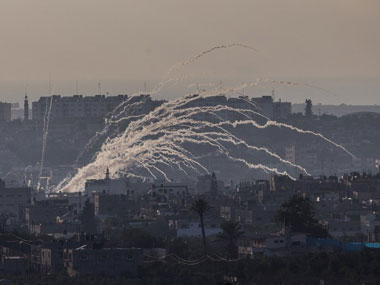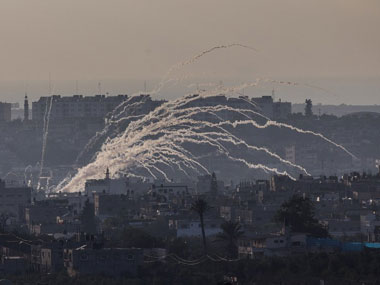In the last four days, hostilities between Israel and Hamas have escalated dramatically as the death toll in Gaza mounted. Israel entered the fourth day of raiding targets in Gaza as Hamas retaliated by launching rockets, with neither side showing signs of backing down. So far, the Israeli military has carried out more than 1,000 strikes against Gaza targets that have killed at least 95 people, including dozens of civilians. Here is all you need to know about the deepening conflict in Gaza and the humanitarian toll so far: [caption id=“attachment_1610049” align=“alignleft” width=“380”]  Smoke billows after an Israeli air strike in areas of southern Israeli border with the Gaza Strip. AFP image[/caption] The war Israel has hit close 1,100 targets so far and has 30,000 reservists on stand to pursue a ground offensive, if needed. Gaza militants fired more than 420 rockets against Israel in the four-day offensive of which several were over Tel Aviv and central Israel. Some of these rocket’s were 100 kilometres deep into the country covering an area of about 5 million, highlighting Hamas’ long range capabilities. “Hamas has several hundred rockets with ranges of up to about 50 miles, which can reach the outskirts of Jerusalem; several thousand rockets with ranges up to 25 miles, many made in China, which can reach Beersheba, Ashdod and other parts of southern Israel; and several thousand rockets with ranges of 12 miles, which can reach the closer Israeli populations in Sderot and Ashkelon,” New York Times reported. Several of these rockets were intercepted by Israel’s “Iron Dome” defense system, says a report . By shooting down more than 90 percent of its targets, the system is ensuring Israel’s decisive technological edge that has helped it operate virtually unhindered in Gaza. Beyond some jitters and discomfort, Hamas has not been able to hurt the Israelis much, causing no casualties and very little damage. Israel has deployed seven batteries across the country that — coupled with a high-tech warning system — have given it its best defensive capabilities ever. Iron Dome quickly recognizes the trajectory of incoming rockets and whether they are headed for major population centers. Those are shot down, while others are allowed to fall in empty fields to spare the hefty cost of firing the sophisticated interceptors. Local reports say each launching costs about $20,000. The lack of a strong defence system has left Hamas-administered areas susceptible to Israeli strikes as evidenced by the mounting death toll and damage numbers. The death toll A report in Washington Post rubbishes Israel’s claims that civilians were not being harmed in air strikes which have pounded Gaza for four days. “Israel insists that it’s cracking down on the threat posed by the Islamist group Hamas and that it is taking pains to avoid civilian casualties. But civilians are dying. According to Gaza’s Health Ministry, which is administered by the territory’s Hamas-dominated government, Israeli airstrikes in the past few days have killed at least 83 people, including 21 children age 16 and younger," writes Ishaan Tharoor citing Beirut-based newspaper al-Akhbar. Al Jazeera, who is also keeping track of the casualties in Gaza reported 98 people had been killed in Gaza by 5pm Friday. Al Jazeera’s report also shows several children under the age of ten among the list of casualties in Gaza. Tharoor’s report lists at least 16 names of children. As always with Israel-Palestine, the identity of the victims has become a point of contention. The Guardian reports:
Israel’s targeting of civilian homes has raised the death toll in Gaza to 81, most of them non-combatants and half of them women and children according to Gaza health ministry figures. In a statement, the Israeli army defended its actions, saying it had struck several houses in Gaza that were being used for “military purposes”, such as " weapons storage, command and control centres, or communications”.
Why now? The ongoing hostility, which is the worst flare up in tensions since the 2012 Israeli air raids of Gaza, began after three Israeli teenagers were kidnapped from West Bank on their way back from school on 12 June and their bodies recovered outside Hebron on 30 June. As an alleged revenge, three Israelis abducted and murdered a 16-year old Palestinian boy on 2 July. The three arrested by Israeli law enforcement confessed to the crime, however the Palestinian teen’s killing sparked violence between Arabs and Jews in the region as Israeli Prime Minister Benjamin Netanyahu pledged to take revenge. On 2 July, conflict began escalating after Israel carried out first set of raids in Gaza, responding to Hamas’ attacks. “As clashes took place in a usually quiet part of Jerusalem, rocket attacks from Gaza into southern Israel increased. Israel carried out airstrikes targeting militants in Gaza,” CNN reported. Next day, Israeli airforce had conducted 15 air raids as both sides intensified military offence. Israeli brigadier general Michael Herzog writing in The Guardian blames Hamas for the inciting the bloody confrontation, “Betting on Israel’s reluctance to invade Gaza, Hamas wants to demonstrate “resistance” to Israeli pressure and show off its capabilities, including long-range rockets and offensive operations using naval commandos and tunnels. Yet not only have these attempts so far been thwarted, but Hamas seems to have miscalculated yet again. Israel does not tolerate such barrages for long," Herzog argues. Al Jazeera, however, reports that the Israeli offensive is a result of domestic pressures on Prime Minister Netanyahu who is in a coalition government:
Foreign Minister Avigdor Lieberman, meanwhile, has revived his bi-annual call to reoccupy Gaza. He announced on Monday that his political party, Yisrael Beiteinu, would end its 18-month-old unity pact with Netanyahu’s Likud, at least partly because of disputes over Gaza policy. “The situation in the government is such that if they let go now, politically, they will suffer. The people in the south will never forgive them. They can’t stop the operation,” said Shmuel Sandler, a political science professor at Bar-Ilan University.
What next? The United Nations and other western leaders have repeatedly called for a de-escalation of conflict in the region. US president Barack Obama offered to brier peace talks while United Nations chief warned that Gaza was on a knife edge, urging restraint. But tensions have run high, as Netanyahu ordered the mobilising of ground troops on Gaza border while Hamas showed no signs of dropping assault. Egypt, who played a crucial role in mediating peace talks leading up to the November 2012 ceasefire agreement, demanded Israel to stop bombing Gaza . However, neither side want to blink first in the game of might, which is threatening the lives of thousands.


)

)
)
)
)
)
)
)
)



